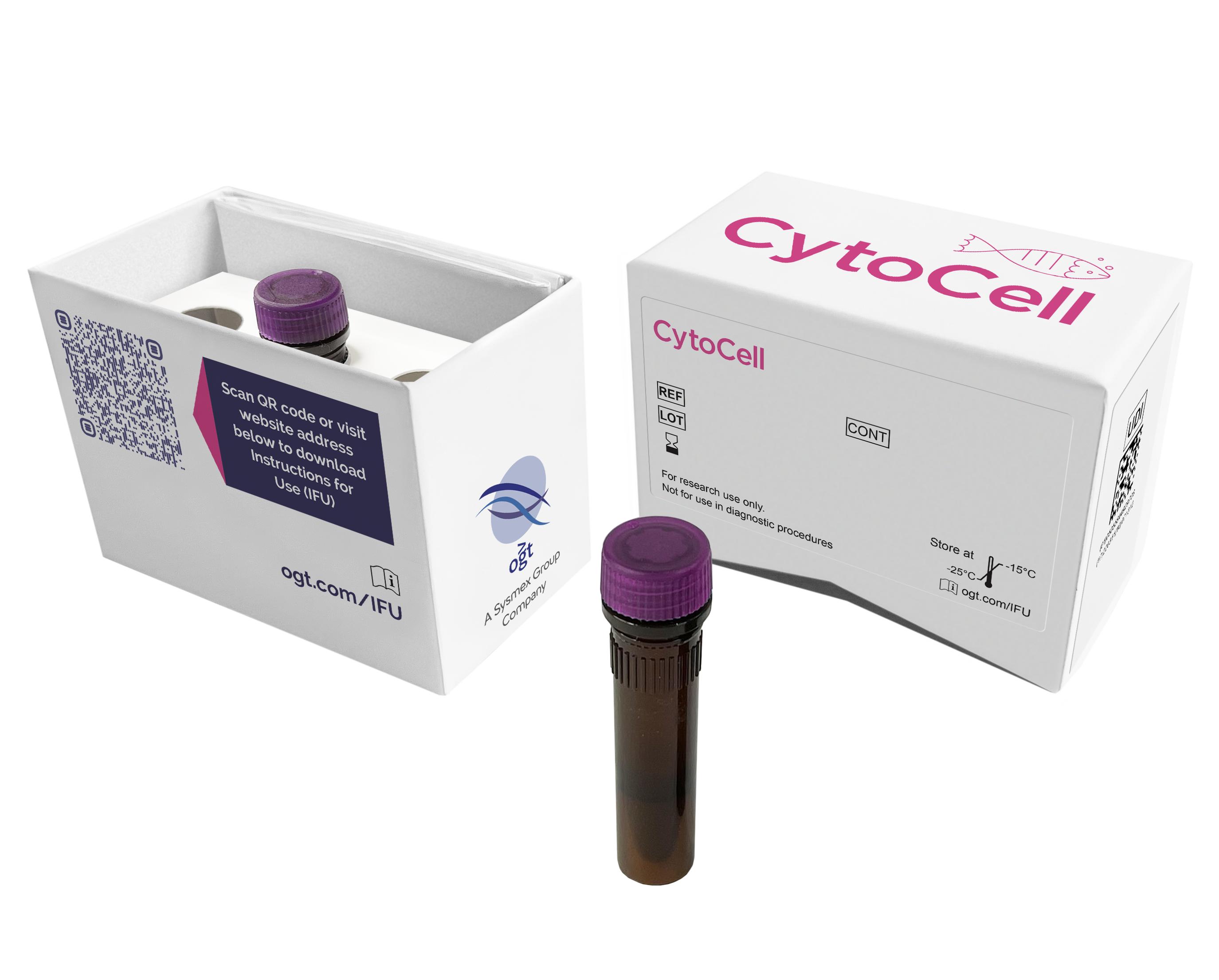
The P53 probe mix consists of a 161kb probe, labelled in red that covers the whole P53 (TP53) gene and the flanking regions. The probe mix also contains a control probe for the 17 centromere (D17Z1) that is labelled in green.
The TP53 (tumor protein p53) gene at 17p13.1 is a tumour- suppressor gene that has been shown to be deleted in a wide range of human malignancies.
The TP53 gene is one of most important tumour suppressor genes; it acts as a potent transcription factor with fundamental role in the maintenance of genetic stability. Screening for TP53 loss is important as deletions or losses of the short arm of chromosome 17, which includes the TP53 region, are reported in many cancers and are often associated with disease progression, inferior response to treatment and/or a poor prognosis.
In particular, loss of TP53 is reported in 10% of patients with chronic lymphocytic leukaemia (CLL), and is considered to be the poorest prognostic marker in that disease1,2. In acute myeloid leukaemia (AML) and acute lymphoblastic leukaemia (ALL), TP53 loss is associated with a poor outcome and is often seen as a marker of disease progression or secondary disease3-5.
TP53 loss in patients with multiple myeloma is a late event, where is seen as a marker of disease progression and is associated with a very poor prognosis6,7.
In non-Hodgkin lymphoma, TP53 losses are reported in diffuse large B- cell lymphoma (DLBCL) often as part of ‘dual-hit’ lymphoma or plasmablastic phenotypes8. In mantle cell lymphoma (MCL), TP53 losses are associated with a poor outcome, and with a dismal outcome when seen with concurrent CDKN2A deletions9.
Find certificate of analysis documentation for our CytoCell FISH probes

Our lab has been using a wide range of CytoCell FISH probes for a number of years, and have been increasing this range all the time. The probes have clear bright signals and show good reproducibility. CytoCell provides fast delivery of catalogue probes, and are very responsive when we have any queries or problems with their products.

Bridget Manasse
Addenbrookes Hospital, Cambridge University Hosiptals NHS Foundation Trust, UK
In our hands, CytoCell FISH probes have proven to be of the highest quality with bright, easy to interpret signals, thus providing confidence in our results. OGT's customer support is outstanding, as their staff are extremely knowledgeable and truly care about their customers and their customers’ needs.

Jennie Thurston
Director of Cytogenetics, Carolinas Pathology Group, USA
I first came across CytoCell FISH probes in a previous lab I worked in and I was struck by the quality of the products. Since this time, I have been recommending and introducing CytoCell probes across all application areas — now they are the primary FISH probes used in our lab. They have an excellent range of products and their ready-to-use reagent format saves considerable time.

Elizabeth Benner
Medical Technologist, University of Arizona Health Network, USA
We have been working with CytoCell fish probes for two decades because of their excellent clarity and intensity regardless of the size of the probe. It is so clear and simple to detect.
Dr. Marina Djurisic
Head of Laboratory of Medical Genetics, Mother and Child Health Care Institute of Serbia “Dr Vukan Cupic”, Serbia
The quality and consistency of CytoCell’s probes means I can trust the results, and my clients get their results in a timely manner.

Dr. Theresa C. Brown
Director, Cytogenetics Laboratory, Hayward Genetics Center, Tulane University School of Medicine, USA
It was very important for us to have more consistent results with our probes — easy-to-read bright signals and a range of vial sizes, which is much more cost-effective.

Janet Cowan, PhD
Director of the Cytogenetics Laboratory, Tufts Medical Center, USA
Not only do CytoCell offer an extensive range of high-quality FISH probes, the customer support is also excellent — providing fast access to all the probes I need. The probes are highly consistent with bright signals allowing easy scoring of results.
Dr. Eric Crawford
Senior Director, Genetics Associates Inc., USA
The quality and reproducibility of results using the CytoCell kit has been vital in accurately detecting co-deletions in our glioma investigations. We now have a cost-effective test that we can rely on that is also easy to use and interpret. We've been consistently impressed with this kit - not to mention the support offered by OGT's customer service, and have completely transitioned over to CytoCell probes.
Gavin Cuthbert, FRCPath
Head of Cancer Cytogenetics, Northern Genetics Servce, Newcastle, UK